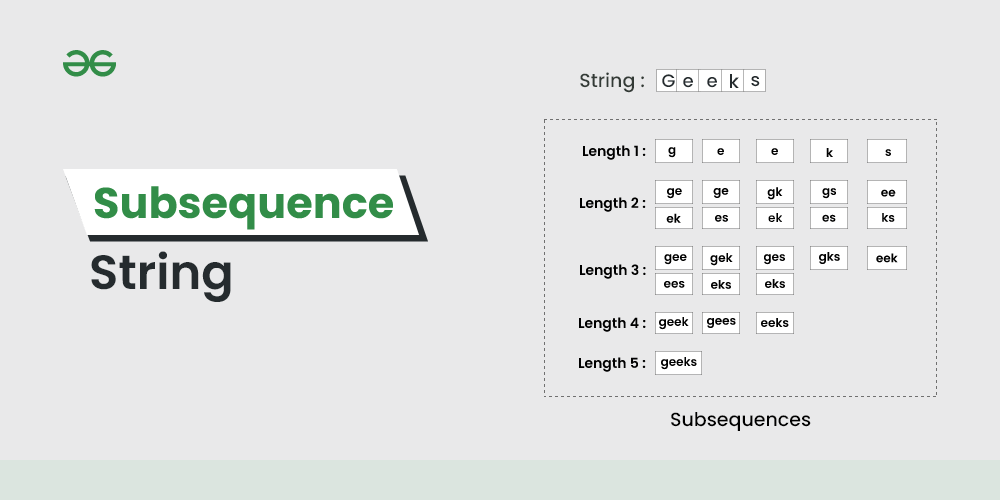What are Subsequences in an Array?
Last Updated :
20 Dec, 2023
Subsequences are a fundamental concept in computer science and programming when working with arrays. A subsequence of an array is a sequence of elements from the array that appear in the same order, but not necessarily consecutively. In this blog post, we’ll discuss subsequences, covering their definition, use cases, examples, when to use them, when not to use them, best practices, and common problems, and provide working code examples in C, C++, Java, Python, and JavaScript.

Subsequences
Definition: A subsequence of an array is a sequence of elements from the array, maintaining their relative order, but not necessarily appearing consecutively. Elements in a subsequence may be separated by other elements.
Full Form: The term “subsequence” does not have a full form, as it is a compound word formed from “sub” (meaning ‘under’ or ‘less than’) and “sequence” (meaning an ordered set of elements).
Use Cases of Subsequences:
Subsequence’s in arrays find applications in various domains, including:
- Data Analysis: Identifying patterns in data sequences.
- Text Processing: Searching for specific phrases or patterns within text.
- Genomic Data: Analysing DNA sequences.
- Dynamic Programming: Solving optimization problems.
- Pattern Recognition: Recognizing recurring patterns in images or signals.
- Natural Language Processing: Extracting meaningful phrases from sentences.
Examples:
Let’s look at some examples of subsequence’s in arrays:
Data Analysis Consider the array [2, 4, 1, 7, 3]. A subsequence of this array could be [2, 1, 3], which maintains the order of elements but skips some.
Text Processing In the sentence “The quick brown fox jumps over the lazy dog,” a subsequence could be “quick jumps dog.”
Genomic Data In a DNA sequence “ACGTACGTA,” a subsequence might be “CAT,” which is a meaningful sequence of nucleotides.
When to Use Subsequence’s
You should consider using subsequence’s when:
- You need to identify patterns or structures in ordered data.
- Solving optimization problems with dynamic programming.
- Analysing sequences in various domains like genetics, text, or signal processing.
- Extracting meaningful information from a larger dataset.
When Not to Use Subsequence’s
Avoid using subsequence’s in the following scenarios:
- When the order of elements in the array is not significant.
- For problems where you need to consider only contiguous elements (use subarrays in such cases).
- In situations where you’re dealing with unordered collections (use sets or bags instead).
Best Practices
To effectively work with subsequence’s, consider these best practices:
- Carefully define the problem and understand the constraints.
- Implement efficient algorithms, as some subsequence problems can be computationally expensive.
- Use dynamic programming when solving optimization problems with subsequence’s.
- Be mindful of potential memory and performance issues, especially with large datasets.
Common Problems and Solutions based on subsequences:
Working Code Examples
Below is the implementation to print subsequence’s of an array:
C++
#include <iostream>
#include <vector>
void printSubsequences(std::vector<int>& arr, int index,
std::vector<int>& subsequence)
{
if (index == arr.size()) {
for (int i = 0; i < subsequence.size(); i++) {
std::cout << subsequence[i] << " ";
}
std::cout << std::endl;
return;
}
subsequence.push_back(arr[index]);
printSubsequences(arr, index + 1, subsequence);
subsequence.pop_back();
printSubsequences(arr, index + 1, subsequence);
}
int main()
{
std::vector<int> arr = { 1, 2, 3 };
std::vector<int> subsequence;
std::cout << "Subsequences:" << std::endl;
printSubsequences(arr, 0, subsequence);
return 0;
}
|
C
#include <stdio.h>
void printSubsequences(int arr[], int n, int index, int subsequence[], int subLength) {
if (index == n) {
for (int i = 0; i < subLength; i++) {
printf("%d ", subsequence[i]);
}
printf("\n");
return;
}
subsequence[subLength] = arr[index];
printSubsequences(arr, n, index + 1, subsequence, subLength + 1);
printSubsequences(arr, n, index + 1, subsequence, subLength);
}
int main() {
int arr[] = {1, 2, 3};
int n = sizeof(arr) / sizeof(arr[0]);
int subsequence[n];
printf("Subsequences:\n");
printSubsequences(arr, n, 0, subsequence, 0);
return 0;
}
|
Java
public class SubsequenceExample {
public static void printSubsequences(int[] arr, int index, List<Integer> subsequence) {
if (index == arr.length) {
for (int num : subsequence) {
System.out.print(num + " ");
}
System.out.println();
return;
}
subsequence.add(arr[index]);
printSubsequences(arr, index + 1, subsequence);
subsequence.remove(subsequence.size() - 1);
printSubsequences(arr, index + 1, subsequence);
}
public static void main(String[] args) {
int[] arr = {1, 2, 3};
List<Integer> subsequence = new ArrayList<>();
System.out.println("Subsequences:");
printSubsequences(arr, 0, subsequence);
}
}
|
Python3
def print_subsequences(arr, index, subsequence):
if index == len(arr):
print(*subsequence)
return
subsequence.append(arr[index])
print_subsequences(arr, index + 1, subsequence)
subsequence.pop()
print_subsequences(arr, index + 1, subsequence)
if __name__ == "__main__":
arr = [1, 2, 3]
subsequence = []
print("Subsequences:")
print_subsequences(arr, 0, subsequence)
|
C#
using System;
using System.Collections.Generic;
class Program
{
static void PrintSubsequences(List<int> arr, int index, List<int> subsequence)
{
if (index == arr.Count)
{
foreach (int num in subsequence)
{
Console.Write(num + " ");
}
Console.WriteLine();
return;
}
subsequence.Add(arr[index]);
PrintSubsequences(arr, index + 1, subsequence);
subsequence.RemoveAt(subsequence.Count - 1);
PrintSubsequences(arr, index + 1, subsequence);
}
static void Main()
{
List<int> arr = new List<int> { 1, 2, 3 };
List<int> subsequence = new List<int>();
Console.WriteLine("Subsequences:");
PrintSubsequences(arr, 0, subsequence);
}
}
|
Javascript
function printSubsequences(arr, index, subsequence) {
if (index === arr.length) {
console.log(subsequence.join(' '));
return;
}
subsequence.push(arr[index]);
printSubsequences(arr, index + 1, subsequence);
subsequence.pop();
printSubsequences(arr, index + 1, subsequence);
}
const arr = [1, 2, 3];
const subsequence = [];
console.log("Subsequences:");
printSubsequences(arr, 0, subsequence);
|
Output
Subsequences:
1 2 3
1 2
1 3
1
2 3
2
3
Time Complexity: O(2N)
Auxiliary Space Complexity: O(N)
Conclusion
Subsequences in arrays are a powerful concept used in various domains, offering insights into data, patterns, and optimization problems. Understanding their definition, use cases, and best practices is crucial for efficient problem-solving. While working with subsequence’s can be challenging, the solutions to common problems are often rooted in dynamic programming, recursion, or clever algorithms. Explore and experiment with subsequence’s to unlock their potential in your programming endeavours.
Share your thoughts in the comments
Please Login to comment...